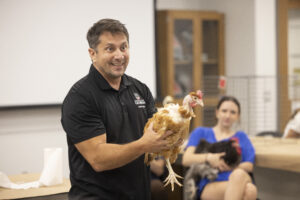We may call ourselves the Peach State, but when it comes to raw numbers, poultry is unquestionably the king of Georgia agriculture.
And the chicken business is booming.
On an average day, Georgia farmers produce 30 million pounds of chicken, 7.8 million table eggs, and 6.5 million hatching eggs, contributing more than $25 billion to the state economy every year.
For decades, researchers in the University of Georgia’s Department of Poultry Science have worked at the forefront of the discipline, and their innovations in genetics, nutrition, and disease prevention have transformed the industry both at home and abroad.
Now, scientists working in this critical field will reach even greater heights thanks to the addition of a new state-of-the-art Poultry Science Building on UGA’s main campus. The $54.1 million, five-story structure comes equipped with more than 70,000 square feet of research and instruction space that will allow students,
Opening New Doors
The original Poultry Science Building opened during the Eisenhower administration on East Campus Road. It hosted one of the state’s most important departments for more than half a century, but the facility was not keeping pace with the work being done inside.
“Issues facing the poultry sector have grown inordinately complex. Faculty in our prior space were mostly within their own labs,” says Todd Applegate, chair of the Department of Poultry Science. “In our new building, we have clustered faculty into six thematic areas to face these current and future issues. Additionally, this environment allows our students a more robust experience garnering different research perspectives.”
Every classroom, student innovation space, and research lab in the new Poultry Science Building has been planned down to the individual chair. It includes massive, modular classrooms that give students comfortable spaces to learn, plus a basement facility where chicks and hens of all ages and sizes can be cared for. The walls are adorned with local, chic farm art, and the frosted doors feature environmental patterns that reflect the industry. That’s largely thanks to the support of donors and alumni, who had valuable experiences of their own in poultry science.
We wouldn’t be able to have a Chick-fil-A sandwich for under $9.50 if we didn’t make the progress that we do in our departments.” — Andrew Benson, associate professor in poultry science
Hands-on, innovative education is a cornerstone of the new building and the program it houses. For example, associate professor Andrew Benson BSA ’02, PhD ’06 incorporates lessons in anatomy and surgical demonstrations into his courses, lessons that would be difficult to teach in regular laboratories.
Benson aims to show students the real-world implications of their studies. His own work, which centers on fertility improvements, has allowed farmers to significantly increase the number of healthy chickens hatched and raised for the poultry industry.

Associate professor Andrew Benson hosts “Hug a Chicken Day” for his Introduction to Poultry Science class. (Photo by Peter Frey/UGA)
“Every one of our labs is engaged with research that is addressing a need or opening up future endeavors for the poultry industry,” Benson says. “We wouldn’t be able to have a Chick-fil-A sandwich for under $9.50 if we didn’t make the progress that we do in our departments.”
Benson utilizes two different 1,500 square-foot learning labs lined with microscopes, incubators, and other scientific tools to help students participate in the research process. That’s just a few floors beneath two new, specialized research labs at the ready for students and faculty.
“I get to teach the course that I fell in love with, and that’s really why I like the new building the most,” he says. “Everything that I fell in love with about this department is still intact. Now, it just has a prettier face.”
A New Generation of Poultry Scientists
It’s not just the prestige of the new building that keeps poultry science alumni involved with the department.

Outreach specialist Sarah Beth Kersey (center) convenes with students (from left to right) Jalen Potter, Anna Thomas, Cooper Mattox, and Tianna Ramey in the foyer of the new Poultry Science Building. (Photo by Peter Frey/UGA)
Sarah Beth Kersey BSA ’24 was in eighth grade when she and her class toured UGA’s old poultry science building on a field trip.
“I fell in love with the department,” Kersey says. “After the open house, I was completely set on coming to UGA and studying poultry science. We are bringing that strong community forward, and the new building is the icing on top of the cake.”
After earning her bachelor’s degree in poultry science, Kersey wanted to give back by reaching out to the next generation. She’s doing just that as a communications and outreach specialist for the department while also pursuing a master’s degree in agricultural education in the College of Agricultural and Environmental Sciences.
“Education is the common goal for my job. Being able to apply what I learned in the classroom about poultry and then show how it works in daily life is really big. I think it adds a unique aspect of poultry science—learning, then helping people expand their knowledge,” she says.
Associate professor Brian Kiepper MS ’03, PhD ’07 knows something about building up future poultry scientists. As the teacher behind a very popular introductory course in the field, he instructs 350 students every semester.
“My whole focus is for our students to understand how agriculture changed it all,” says Kiepper. “When they leave the University of Georgia as a doctor, lawyer, teacher, engineer, or whatever, they can be that because of agriculture. They couldn’t if somebody else didn’t take on the responsibility of creating those calories you need to survive.”
Kiepper can be creative in his teaching. For instance, in his First-Year Odyssey Seminar, “Chicken Que: Science Behind the Grill,” students prepare, flavor, and cook their own meals from scratch to truly understand the farm-to-table perspective.
It’s a creative way to learn about such an important industry beyond just numbers and slides. With the minds of the poultry science department and the capabilities of the new building, Georgia’s poultry leadership is well positioned to grow.
“When you see our new building, it really is a place to show people what we do,” Kiepper says. “With the old building, we had to entice people into poultry science. Now, with the new building, it’s almost like it makes that stamp itself.”

Abit Massey – A Lifetime of Leadership: A key component of the new poultry science building is the Abit Massey Classroom. Massey BBA ’49, who died in June, was a poultry industry giant, a beloved entrepreneur, and a strong UGA supporter. Following his graduation from the Terry College of Business, Massey’s tenure as executive director of the Georgia Poultry Federation made Georgia the poultry leader it is today. The classroom, adorned with a large display and official lettering, is dedicated to his memory, and it recognizes his role in making the university and the state a leader in the poultry sector. (Photo by Andrew Davis Tucker/UGA)
Source: The University of Georgia





















Letter to the Editor: Workplace injury numbers in poultry industry need closer look
As FSN noted recently, the Bureau of Labor Statistics reported that poultry slaughter plants had a huge and unprecedented reduction in the number of workers injured this year: the industry injury rates were more than halved from the year before. The BLS data also showed that poultry plants reduced their most serious work injuries that involve lost time or restricted duty by more than two thirds in just one year. What the FSN story didn’t report was that these numbers are based on data collected and reported by the industry, and the data are not checked or validated. Though the FSN story led with a celebration of these numbers, there are very serious questions about these self- reported numbers and whether they are real or a mirage.
Over the past decade three government agencies (USDA, OSHA and NIOSH) have found that the poultry industry’s self-reported injury numbers are seriously underreported. Congressional investigations also documented this in a 2021 Congressional Committee report that found that the poultry industry flagrantly underreported the number of their workers sick with COVID-19 by two thirds.
Many of us were startled to see this one year unprecedented decrease in self-reported cases by the industry. For those of us that follow worker safety in the industry, we didn’t hear from workers about any new improvements or changes that would lead to this drop. The last published studies of repetitive trauma injuries, like carpal tunnel syndrome, in poultry plants were performed by the National Institute for Occupational Safety and Health (NIOSH) in2012 and 2014. NIOSH performed medical exams and found alarmingly high rates of carpal tunnel syndrome among line workers — rates from 34 percent to 42 percent.
Taking a closer look at these BLS numbers may help explain why they may be a mirage: BLS numbers are calculated from a company’s self-reported injury logs that contain only those injuries/illnesses that the company deemed were work related and where the worker received medical treatment from a doctor. If the plant does not send workers to a doctor for treatment, they would have very few cases on their logs.
In poultry plants, government investigations found that injured and ill workers were seen in onsite health units and rarely referred to a doctor for medical evaluation and treatment. The onsite clinic staff only provided first aid to the injured worker—not ‘medical treatment’ that would be considered a ‘recordable’ injury.
A recent article in the American Medical Association’s Journal of Ethics documented myriad government investigations in big poultry plants that found that the onsite health clinics routinely send injured and ill workers back to jobs that cause their injuries, instead of sending workers to a doctor for a diagnosis and treatment. In some cases, workers went to the onsite clinics dozens of times with the same injury, never to be sent to a doctor. In these cases, effective treatment was delayed, and workers’ injuries worsened leading to surgery and other bad outcomes.
When a worker’s condition worsens and they then go to see a doctor on their own, the companies claim these injuries are not work related. The companies don’t pay for the medical treatment, and the injuries are not recorded. Studies and investigations also found that workers may be intimidated into not reporting work related injuries and illnesses for fear of losing their jobs.
The high turnover in the poultry industry, between 60 percent to 150 percent a year, is often thought to be a consequence of injured workers who can no longer do the job, don’t get to be seen by a doctor to get adequate diagnosis and medical treatment to recover —and must leave the industry. Of course, these injuries are also not recorded on the companies’ logs.
A closer look behind these numbers is warranted. What incredible improvements implemented last year have led to this drop? Are these low recordable injury rates really a reflection that the companies are much safer?
Source: Food Safety News